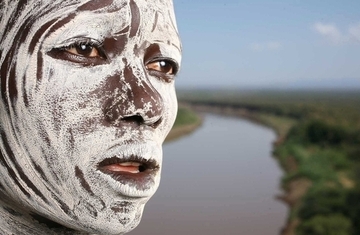
Tadias Magazine
Publishers’s Note:
Published: Thursday, March 5, 2009
New York (Tadias) – The following narrative is penned by Chester Higgins, Jr. He is one of the most significant photographers of his generation. He has been a staff photographer at The New York Times since 1975. One of the most indelible images of Emperor Haile Selassie was captured by him in 1973 in Addis Ababa. Higgins’ most recent photographs focus on the peoples of the Omo Valley of Ethiopia.
Omo Spirit: by Chester Higgins, Jr
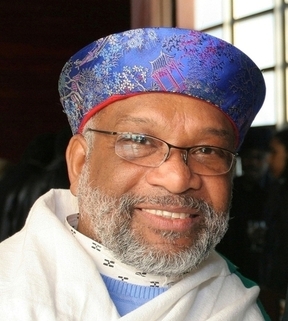
Chester Higgins, Jr
I’m from that house, perched on a slope — near the gully, in that farming village of 800 people, inside the triangle of Alabama, Georgia and Florida. At the small age of nine, a dazzling light appeared in my room in the middle of the night, snatching me from sleep. At first, I was fearlessly curious. When I heard a voice coming out of the light, I screamed. Only decades later did I come to understand and appreciate the significance of this night and accept that perhaps I had been reached, my coordinates known, by the light of the Spirit.
In my part of the country people spoke matter-of-factly of “the Spirit.” I witnessed my Great Aunt talking away the pain of burned flesh and mixing herbs, and the enthusiastic, often shuddering, joyous celebration of the community of men and women touched by the Spirit each Sunday. Today, I find that interplay between our world of flesh and the Spirit still existing in Ethiopia. I felt it most acutely when I traveled this year to the South among the Omo people.
A year ago, I began to research these diverse groups of southern people who live in a triangle of Ethiopia, Sudan and Kenya. Since my first trip to Ethiopia in 1973, I have heard stories of their life, once isolated, but lately being encroached on by tourists and insensitive government policies. The loss of land has made survival for some of the Omo groups precarious. I have long wanted to work with them.
Searching images and writings about these ancient groups, I found little to suggest their voices have been heard or their true faces seen. Too often when we photograph “exotic” cultures—people of Nature— otherness prevails. Would the people trust me enough to allow me to work with them? Something deep stirred within me. My challenge became to give voice to the sacred Spirit buried inside the veins of each of them.
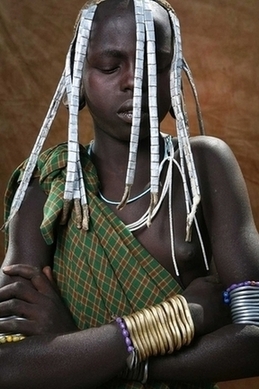
copyright 2009 Chester Higgins, Jr.
When I first encountered the Omo, I had to think about how much of what was before me was a shadow of the past, smoke of the present or a light from the future. In their homeland the relationship among the people, the land and the sky guides life in very pragmatic ways, revealing something about their spiritual sense of the cosmos. Against a dramatic starry backdrop, the Omo look for the sun’s appearance in different places on the horizon to tell the seasons. When twilight reveals the four stars of the Southern Cross, the two Pointers rising in a straight line at sunset and falling to the horizon at sunrise, they know the Omo River will soon flood. It is time to migrate to higher ground. When the flood recedes, they return to plant their crops.
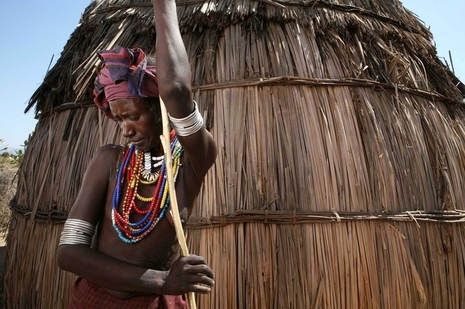
copyright 2009 Chester Higgins, Jr.
Culturally, the Omo’s definition of beauty and self-worth is radically different from the Western ideals I grew up around. Spiritually,they are human vessels brimming with the Spirit, very much akin to the folks of my childhood. They are anchored between the ground and the sky, flanked by yesterday and tomorrow. Looking into their eyes, I found myself in an intensity of spiritual reflection I was familiar with. Each subject’s face, countenance, accessories, decorative paint, scarification or tattoos and piercing was merely the starting point.
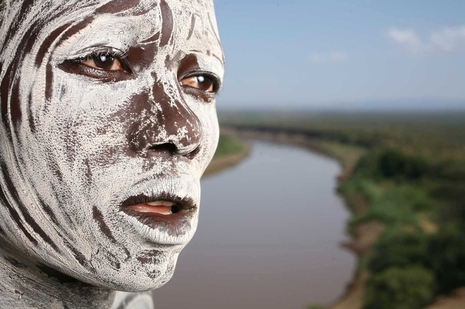
copyright 2009 Chester Higgins, Jr.
What matters is what is going on inside. Could I find and connect with an engaging Spirit within people in what appeared to be such an alien culture? I came to each village with an interpreter specifically to sit with the village elders. I carefully selected candidates for my portraits, reaching out to touch each person to sense if our Spirits would spoon into each other. To make authentic interior images, I must have the complete cooperation of the subject.
I brought a full studio to southern Ethiopia. Technically for me the most important consideration in any photograph is light — or its absence. I find the light in Ethiopia to be the clearest. In the Amharic
language, the word for light is mebrat—a woman’s name. At an early age, I found pleasure in studying the nuances of light, watching its dance and its penumbra. I like to say that light is my mistress. She has been a major asset, helping me see more clearly.
Before the portrait sessions, I anchored cloth backdrops to light stands or just set up lights against a natural backdrop — creating a studio without walls. The burst of strobe first frightened my subjects, but once they understood that the careful preparations were directed at producing clearer representations of themselves, they began to place their trust in me, opening to reveal a deeper self, peeling away suspicion and reservation. To behold fully what is in front of my eyes, I always put my trust in the Spirit within to recognize the Spirit outside. When everything is complementary, an embrace can take place. I am invigorated when I feel this connection; it just happens. I believe the Spirit allows itself to be visualized, but refuses to be made a captive. But only when it manifests through the flesh can a subject’s interior be revealed.
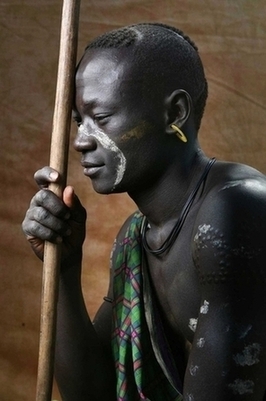
copyright 2009 Chester Higgins, Jr.
During my sessions with the Omo, I felt that our Spirits embraced, leading me through moods and perspectives unique to the moment — and unique to them. I’ve since returned to New York, but the Omo people remain in their ancestral home, watching the heavens, by day the sun and at night the stars, that comfort their mystical dreams — dreams too deep for me to fathom. I made a visual litany with my camera, capturing the lines in their faces that mirror their spiritual trekking in time. I think of these images as a testament to spiritual moments that will remain an afterglow to their physical existence — much like a speeding meteorite, yet another expression of existence by the Spirit.
Learn more at ChesterHiggins.com


























Dear Chester,
This is indeed a great narrative about the Omo people. I wish you introduce your new friends by names. I sincerely appreciate your creative and spiritually motivated project, a project that has successfully displayed the complex and diverse landscape of humanity in Ethiopia. I am glad that the outside world will now have a chance to frame Ethiopianity beyond the alpines of northern Ethiopia. I look forward to reading and viewing the fruits of your photography in south Ethiopia. Ayele
Dear Ayele,
Point well taken. My oversight. It won’t happen again.
Chester
Chester,
That is a candid SPIRIT narrative from the Ethiopian south. Look forward to a visual story. Great work!
Tefera Ghedamu
Dear Chester
Great story. Do you have a site where you can share to view all of your art works?
BTW: This is Rahel Tekabe….. It has been a long Long Long Time since I’ve seen you
Dear Chester,
Great work! I enjoyed the spiritual similarities you drew between Africans in diaspora (your family) and the Omo people in Africa. I was thinking about you today because I was visiting Ifetayo Cultural Arts Academy on President street in Brooklyn, where my girls are taking some Amharic and African dancing lessons. I do recall you were telling us about this project over the fantastic dinner at your place. Great work, and I look forward to seeing more.
Rebka
http://www.drmammo.org
Chester,
Job well done. Keep up the great work!!!
That was really what I felt in my first trip to the Omo valley. Thank you for the wonderful explanation you did of the people. This is Africa, the root of mankind.
Michael, ETV, A ddis Ababa
GREAT narrative…what an amazing people. Thank you for sharing your art.
Dear Chester.
I was wondering, when I saw your photo, I remembered you. I don’t know if you remember me, but we met at Zula Restaurant a long time ago. Your interest in Ethiopian culture is still very fascinating. Your art promotes Africa. Thank you.
Thank you for the photographs of these spirited wonderful people that paint their bodies. I am happy to know that You went to see for yourself. I appreciate your presentation. I hope to see more. I am sorry that there are so few of these people left to learn about. I was wondering if the women also paint themselves for the same reasons as the men and what are their reasons for this display?
Thank you for helping us see the omo people, their customs their traditions and especially their understanding of and relationship to the world they live in.
You’ve painted love with the light in your heart, dear friend. Sitting thousands of miles away, I feel the depth of this connection, this familiar yearning rising beyond words, beyond all forms. Thank you
Things you brought up make a lot of sense. I like it! Greetings!